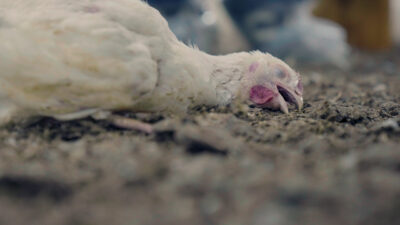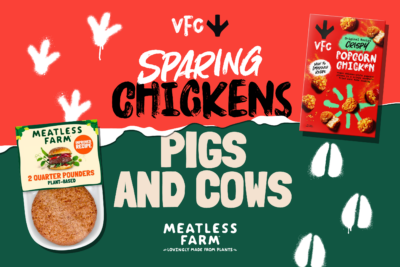The popular imagery of farmed animals living out gentle lives in sunlit fields is very far from reality for most of them. Factory farming has become increasingly commonplace around the world, forcing billions of animals to live short lives in crowded conditions with no access to the outside world. Most are subjected to some kind of mutilation, supposedly for their own welfare, and many will experience abuse in addition to the awful conditions they already have to endure.
1. MALNUTRITION AND OBESITY
The growth of factory farming has resulted in an abundance of cheap and processed meat being sold and consumed, with serious public health consequences. One study found that meat is as responsible as sugar for causing obesity. Being obese increases the risk of developing diseases including type 2 diabetes, heart disease, and several types of cancer.
At the same time as contributing to unhealthy and excessive consumption of food, the increasing conversion of land to grow animal feed instead of food for humans contributes to food insecurity, which increases the risk of malnutrition.
2. CONFINEMENT
On factory farms, animals are kept at high stocking densities, meaning many individuals are kept in as small a space as possible according to the law or the “welfare standards” to which the farm adheres. About 36 percent of eggs sold in the UK come from hens kept in “enriched colony cages”, which hold around 80 birds, each given 750 sq cm of space — slightly larger than an A4 sheet of paper. Pigs, dairy cows, and even farmed fish are all subjected to various space restrictions and overcrowding too. This often causes serious welfare and behavioural problems, including frustration, boredom, and increased social conflict, which can lead to biting, pecking, and cannibalism.
Aside from having little space, many factory-farmed animals rarely if ever get to enjoy the feeling of grass beneath their feet or sunlight on their faces, spending practically their whole short lives indoors.
3. BIRDS ARE DEBEAKED
When layer hens are chicks they have their beaks “‘trimmed” to stop them from pecking or cannibalising each other as they grow. UK government regulations require trimming (no more than a third of the beak) to be carried out using a “suitable instrument”, with any bleeding from the beak cauterised. Beak trimming can cause pain, numbness, and swelling in the beak, which can then also regrow in an irregular way. Beak trimming performed using a “‘hot blade”’ can also lead to bleeding and infection, which can kill the chicken.
4. TAIL DOCKING
Tail docking involves cutting tails off of piglets who are only a few days old, usually without anaesthetic, as a way to prevent them from biting each other’s tails. It is illegal to perform routine tail docking on British pig farms and is supposed to be a last resort when other methods to prevent tail biting have failed, yet according to a report by Animal Equality and The Animal Law Foundation, it is common on 70 percent of farms. Tail biting is a problem on pig farms because these intelligent, curious animals are kept in crowded spaces with little enrichment to keep them occupied.
Not only is tail docking painful and stressful for pigs, but it may also nerve damage that can cause pain later in life.
5. GENETIC MANIPULATION
Farmed animals are selectively bred to make them more profitable. Cows produce twice as much milk as they did 40 years ago, hens lay over 50 times more eggs a year than their wild ancestors, and broiler chickens grow three times faster than breeds used in the 1950s. All this extra growth and productivity takes a toll on their bodies. Inflammation of the udders, known as mastitis, is common among dairy cows. Broiler chickens experience strain on their hearts and lungs and often die from heart attacks, as well as having painful leg disorders due to their excessive weight. Producing a large number of eggs can weaken the bones of laying hens as they draw on their supplies of calcium to make the egg shells, sometimes resulting in fractures and paralysis.
6. VIOLENCE AND INHUMANE TREATMENT
Countless undercover investigations by animal activists have revealed animals being treated violently and inhumanely on farms. Groups including Animal Equality, Animal Justice Project, and Animal Aid have extensively documented the cruelty that farmed animals are subjected to in the UK and abroad, on factory farms and even on so-called higher-welfare and organic farms.
7. SUPERBUGS AND DISEASES
Factory farms are breeding grounds for pathogens that can infect farmed animals and spread to other species. Bird flu, for example, has been tearing through flocks across the world, resulting in millions of chickens, turkeys, and ducks being killed on farms (as opposed to being sent to slaughter), often in horrific ways, to stop it from spreading further. It’s also a risk to human health, with workers on a poultry farm in Russia having contracted the H5N8 strain in 2021 and a young girl having recently died in Cambodia after contracting the dominant H5N1 strain.
Other pathogens also spread easily in factory farms, such as the bacteria Campylobacter jejuni, commonly found in farmed cattle. It’s the most common cause of gastroenteritis and is resistant to antibiotics — the biggest use of which globally is in animal farming. The growth of antibiotic resistance, fuelled by animal agriculture, is considered by the World Health Organization to be one of the most serious threats to public health.
8. DISBUDDING/DEHORNING
Calves in the dairy and beef industries commonly have their horns removed to make them easier to manage. This must be done using anaesthetic, unless using a chemical disbudder, which essentially burns away the horn buds. More commonly, hot irons are used. Disbudding is stressful for the calves, as they must be restrained for it to be performed effectively, and if the anaesthetic doesn’t work properly it can be very painful.
If calves aren’t disbudded, or if their horns grow back after ineffective disbudding, they may be dehorned once they’ve grown, a much more risky and painful procedure.
9. CASTRATION
Castrating male beef cattle is common to reduce aggression, but also to produce meat that fetches a higher price. It is usually carried out when calves are a few days old, either using rubber rings or latex bands, a knife, or a crushing instrument called a burdizzo. Anaesthetic is not legally required to be used for calves less than two months old.
Piglets might also be castrated, mainly to prevent “boar taint”, which is a smell or taste that pork can have that some people don’t like. It’s much more common in the European Union and other countries, and is usually done when the piglets are under a week old, without pain relief.
10. TEETH CLIPPING
Clipping the teeth of piglets is common practice to reduce injuries to each other and to their mother when they are nursing. It should only be performed as a last resort when other efforts to prevent biting have been unsuccessful, but Animal Equality has found that many farmers routinely clip piglets’ teeth without using any anaesthetic. Clipping can cause lesions in the piglets’ gums, fractures, haemorrhaging, and abscesses, all of which are known to be very painful for humans and so are likely to cause serious pain for piglets.
11. BRANDING, EAR NOTCHING, EAR TAGGING
Animals in the UK can be branded for identification by freeze branding with dry ice or liquid nitrogen. The sensation would be similar to being burned with something extremely hot. Ear notching and tagging are other common ways of identifying animals and are routinely done to lambs, pigs, and calves at only hours old. If you’ve ever had a piercing, you’ll have some idea of the pain involved — but while a piercing is a fashion choice, tagging and notching are ways to mark a living being out as someone’s property.
FACTORY FARMING FACTS
SPACE IS A LUXURY
Animals need space to interact healthily with each other and their environments and to get away from other individuals if they wish to. Under factory farm conditions, they are denied this kind of space and have no opportunity to pursue their natural behaviours.
MUTILATION IS COMMONPLACE
Animals are routinely mutilated on factory farms to keep them from injuring each other — which they do mainly because of the conditions in which they live.
LACK OF VETERINARY CARE
In the UK, animals are supposed to receive prompt veterinary care when they are sick or injured, but undercover investigations have shown that this sometimes does not occur. A recent Animal Justice Project investigation into a pig farm revealed how one young pig was left too lame to move much and clearly suffering for more than 10 hours before even being removed from their pen. Another investigation by Animal Equality showed how cows were left to suffer on a dairy farm without proper treatment, with some lame cows left hobbling for days and cows so exhausted that one collapsed during milking. Another was left to suffer and die overnight after miscarrying her calf instead of being euthanised.
FAST GROWTH IS A NECESSITY
Getting animals up to slaughter weight as fast as possible saves the farms money on feed and care and allows them to sell more meat. Chickens in particular suffer from having been selectively bred to grow faster than their bodies can handle. Cows and pigs will be fattened up with grain and soy, while lambs might be grazed on certain grasses to “get them finished quicker” and turn a higher profit.
FOUR TIMES THE HUMAN POPULATION
There were 33 billion chickens on the planet in the year 2020. Add to that roughly 1.5 billlion cows, 1 billion pigs, 1 billion sheep, and 900,000 domestic goats and you have more than four times as many farmed animals as humans.
ANIMALS ARE TREATED LIKE MACHINES
Animals are sentient beings with their own aims and desires about how to live, yet on factory farms they are reduced to machines. In order to keep this system of farming going, animals must be bred, either through repeated artificial insemination, or through industrial hatcheries for chickens. They are also bred to be as productive as possible at the expense of their welfare. Their sole purpose is to be turned into food as quickly as possible for as little cost as possible.
OVER 90 PERCENT OF FARMED ANIMALS GLOBALLY ARE RAISED IN FACTORY FARMS
In 2019 the Sentience Institute estimated that 31 billion land animals and 38.8 billion to 215.9 billion fish are being farmed around the world at any given time, and that 90 percent of these are trapped in the factory farming system. (Factory farms are also known in the U.S. as “CAFOs”, or concentrated animal feeding operations.) This estimate covers 74 percent of farmed land animals and virtually all farmed fish.
CONCLUSION
Factory farms cruelly confine animals and subject them to all sorts of suffering, from routine mutilations to frustration and boredom that leads to abnormal and injurious behaviours. They are also extremely vulnerable to violence and neglect from farm workers. With the vast majority of farmed animals being raised on factory farms, the best way to ensure you aren’t contributing to their suffering is to leave them off your plate entirely.





